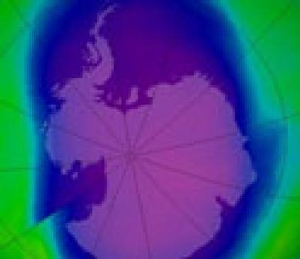Apr 24 2008
A much-discussed idea to offset global warming by injecting sulfate particles into the stratosphere would have a drastic impact on Earth's protective ozone layer, new research concludes.
 Earth's ozone hole, shown in blue, could be exacerbated by some efforts to mitigate climate change. (Credit: NASA)
Earth's ozone hole, shown in blue, could be exacerbated by some efforts to mitigate climate change. (Credit: NASA)
The study, led by Simone Tilmes of the National Center for Atmospheric Research (NCAR) in Boulder, Colo., warns that such an approach would delay the recovery of the Antarctic ozone hole by decades and cause significant ozone loss over the Arctic.
The study results are published today in the journal Science Express. The research was funded by the National Science Foundation (NSF), NCAR's principal sponsor, as well as by NASA and other agencies.
"Our research indicates that trying to artificially cool off the planet may be a perilous endeavor," Tilmes says. "While climate change is a major threat, this solution could create severe problems for society."
"The challenges of global warming mitigation are extremely complex," said Cliff Jacobs, program director in NSF's Division of Atmospheric Sciences. "Continued investment in basic research will allow the most cost-effective solutions--and those of the most benefit to society--to be found."
Climate scientists, concerned that society is not taking sufficient action to prevent significant changes in climate, have studied various "geoengineering" proposals to cool the planet and mitigate the most severe impacts of global warming.
One of the most-discussed ideas is to regularly inject large amounts of sun-blocking sulfate particles into the stratosphere. The goal would be to cool the climate, much as sulfur particles from large volcanic eruptions have cooling impacts.
Since volcanic eruptions temporarily thin the ozone layer in the stratosphere, Tilmes and her colleagues looked into the potential impact of geoengineering plans on ozone.
The new study concluded that, over the next few decades, artificial injections of sulfates could destroy between one-fourth and three-fourths of the ozone layer above the Arctic. This could affect a large part of the Northern Hemisphere because of atmospheric circulation patterns.
The sulfates would also delay the expected recovery of the ozone hole over the Antarctic by about 30 to 70 years, or until at least the last decade of the twentieth century, the authors warn. The ozone layer is critical for life on Earth because it blocks dangerous ultraviolet radiation from the Sun.
"This study highlights another connection between global warming and ozone depletion, which had been thought of as separate problems but are now increasingly recognized to be coupled in subtle, yet profoundly important, ways," says Science Express paper co-author Ross Salawitch of the University of Maryland.
To determine the relationship between sulfates and ozone loss, the authors used a combination of measurements and computer simulations.
They then estimated future ozone loss by looking at two geoengineering schemes--one that would use volcanic-sized sulfates, and a second that would use much smaller injections.
The study found that injections of small particles over the next 20 years could reduce the ozone layer by 100 to 230 Dobson Units. The average thickness of the ozone layer in the Northern Hemisphere is 300 Dobson Units. (A Dobson Unit is a common measure of ozone.)
For large particles, the loss would range from 70 to 150 Dobson Units. The larger figure is correlated with colder winters.
In the Antarctic, the sulfate injections would not significantly reduce the thickness of the already depleted ozone layer. Instead, they would significantly delay the recovery of the ozone hole.
The authors caution that the actual impacts on ozone could be somewhat different than estimated if atmospheric changes led to unusually warm or cold polar winters. They also warn that a geoengineering project could lead to even more severe ozone loss if a volcanic eruption took place at the same time.
"Clearly much more research needs to be conducted to determine the full implications of geoengineering before we may discuss seriously the injection of sulfate aerosols into the stratosphere," says co-author Rolf Müller of the Jülich Research Center in Germany.